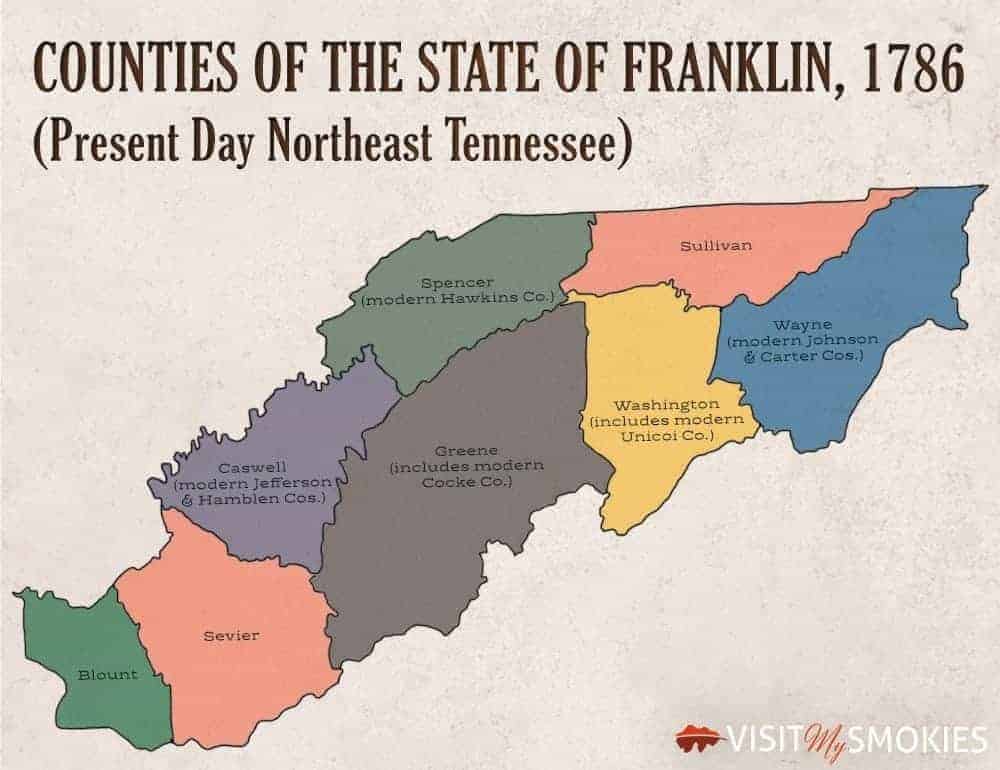
5 Things You Didn’t Know About John Sevier: The Father of Tennessee
Sevier County, TN and the city of Sevierville, TN were both named after John Sevier – and it’s easy to see why! Few people have done more to shape the history of of the Great Smoky Mountains region and the state of Tennessee than Sevier. As a frontiersman, military leader, and the first Governor of Tennessee, John Sevier helped to literally (and figuratively) put Tennessee on the map.
In his 70 years, Sevier led a life that was anything but dull. Visit My Smokies did a little research to bring you five fun facts about John Sevier.
1. He Led the Overmountain Men in a Decisive Revolutionary War Battle
Born and raised in Virginia, John Sevier moved to what is now northeast Tennessee with his brother in the early 1770s to seek a new life on the frontier. When the American Revolution began, Sevier took up the Patriot cause and fought against the Cherokee, who had allied with the British.
(See Also: 3 Cherokee Legends from the Great Smoky Mountains)
Sevier’s most impressive military exploits came at the Battle of Kings Mountain, located near the present day North Carolina – South Carolina border. Prior to the battle, British Loyalists had given an ultimatum to the frontiersman living in the Appalachian Mountains: lay down your arms or their army would “lay waste the country with fire and sword”.
In response, John Sevier and future Governor of Kentucky Isaac Shelby raised armies to fight the Loyalist troops. Sevier helped lead the “Overmountain Men” to victory in the Battle of Kings Mountain, which proved to be a major turning point in the Southern front of the Revolutionary War. Sevier’s success at Kings Mountain was bittersweet, however, as his brother Robert was mortally wounded in the fighting.
2. He Saved His Second Wife’s Life During a Fight with the Cherokee
John Sevier married his first wife, Sarah Hawkins, when he was just 16 years old. Sadly, Sarah passed away in 1780 soon after giving birth to the couple’s 10th child. On the night Sarah died, the threat of a Native American attack was imminent, so Sevier was forced to bury his wife in the middle of a thunderstorm.
Sevier married his second wife, Catherine “Bonny Kate” Sherrill later that year. Four years before they wed, Sevier had saved Bonny Kate’s life during a clash with the Cherokee at Fort Watauga. Sherrill was out milking a cow when the attack began, but the frontiersman had already closed the gates when she returned to the fort. Thinking quickly, Sevier reached over the wall to pull Bonny Kate to safety.
3. Before Tennessee Existed, He Was the Governor of “The Lost State of Franklin”
After the Revolutionary War, John Sevier and other frontiersman pushed for the creation of a new state west of North Carolina. The proposed state was called “Franklin”, in honor of Benjamin Franklin, and would comprise eight counties that are part of present day East Tennessee. Despite popular support for the idea, the U.S. Congress failed to admit Franklin into the Union.
 In defiance of the federal government’s decision, the frontiersman decided that Franklin would continue without official recognition. John Sevier became governor of the extra-legal state and started negotiating his own treaties with the Native Americans. Over the course of Franklin’s four year existence, tensions between the territory and North Carolina grew, and ultimately culminated in a small battle in Jonesborough.
In defiance of the federal government’s decision, the frontiersman decided that Franklin would continue without official recognition. John Sevier became governor of the extra-legal state and started negotiating his own treaties with the Native Americans. Over the course of Franklin’s four year existence, tensions between the territory and North Carolina grew, and ultimately culminated in a small battle in Jonesborough.
After the collapse of the state of Franklin, Sevier was arrested and sent to Morganton, NC to stand trial for treason. However, the local sheriff had fought in the Battle of Kings Mountain, so he released Sevier before the trial.
For an in-depth look at the rise and fall of our almost-14th state, read our blog about the Lost State of Franklin.
4. He Was a Hugely Successful Politician
John Sevier was an incredibly gifted politician. Having narrowly escaped being tried for treason, Sevier swore allegiance to North Carolina in 1789 and was soon elected to the state’s senate. As a legislator, Sevier helped orchestrate the ceding of land west of North Carolina to the federal government.
Congress designated this land as the “Southwest Territory” and appointed John Sevier as the brigadier general of the territorial militia. In 1796, the Southwest Territory was admitted to the Union as the state of Tennessee and Sevier was elected governor. Just 8 years after the demise of Franklin, Sevier was governing a new state that was at least ten times as big!
John Sevier served six terms as governor, from 1796 – 1801 and from 1803 – 1809. Sevier’s political career continued with a stint in the Tennessee state senate followed by his election to the U.S. House of Representatives.
5. His Epic Rivalry with Andrew Jackson Almost Ended in a Duel
If John Sevier had an arch-nemesis, it was definitely Andrew Jackson. The two politicians shared a bitter rivalry that was fueled by both conflicting professional ambitions and personal dislike. During his first term as governor, Sevier had backed Jackson’s opponent in his quest to become major-general of the state militia. To add insult to injury, Jackson also found out that Sevier had called him a “poor pitiful petty fogging lawyer” in a private letter. When John Sevier ran for governor again in 1803, Jackson launched an unsuccessful smear campaign, accusing Sevier of bribery.
The bad blood between John Sevier and Andrew Jackson came to a boil when the two men came face to face in Knoxville after Seiver’s inauguration. During a heated argument, Sevier accused Jackson of committing adultery, and Jackson responded by challenging Sevier to a duel.
In a strange turn of events, Sevier and Jackson accidentally ran into each other on the way to the duel and immediately began shouting at each other. The commotion startled Sevier’s horse so much that it ran away, leaving the governor without his pistols. When Jackson took aim at Sevier with his gun, the governor hid behind a tree.
Soon, the men found themselves in a Mexican standoff, with John Sevier’s son pointing a pistol at Andrew Jackson, and Jackson’s friend aiming his gun at Sevier’s son. Ultimately, the tense situation was resolved without any blood being spilt.
As you can see, John Sevier was certainly one of Tennessee’s most colorful historical figures. For a look at another famous Tennessean, check out our blog about the real Davy Crockett!





Comments are closed.